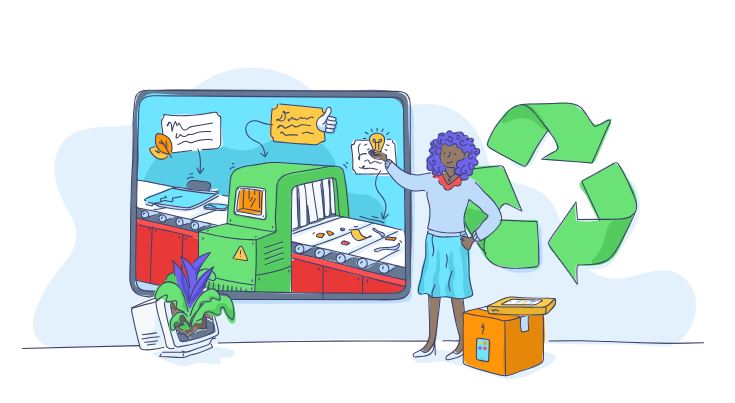This post focuses on IT lifecycle emissions and the responsible disposal of electronic waste to reduce environmental impact, thereby contributing to achieving net zero targets.
The world produces around 50+ million tonnes of electrical and electronic waste (e-waste) a year, worth over $62.5 billion, making it the fastest growing waste stream worldwide – the United Nations calls it a tsunami of e-waste.
In 2019, only 17.4% of e-waste was recycled responsibly. The rest was illegally dumped in low-income countries, exposing workers and children to hazardous and carcinogenic substances. Children as young as five years old are tasked with “processing” e-waste to mine copper and gold. They are commonly exposed to lead, cadmium, mercury, nickel, brominated flame retardants and polycyclic aromatic hydrocarbons.
There is 100 times more gold in a tonne of e-waste than in a tonne of gold ore.
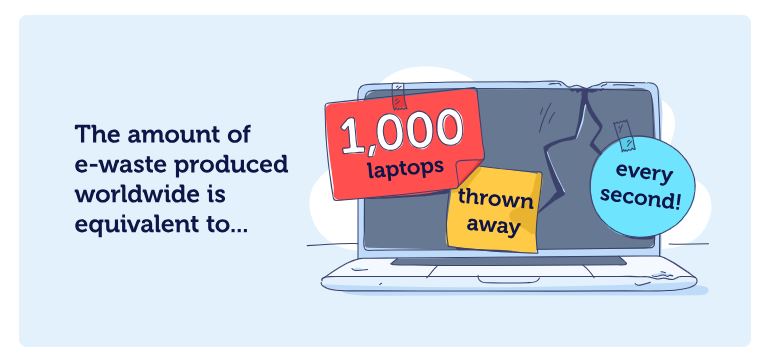
How much e-waste do we produce every year?
Waste from Electrical and Electronic Equipment (WEEE), often referred to as e-waste, consists of electronic products with a power or battery supply that are discarded at the end of their useful life.
The volume of electronic waste generated worldwide in 2019 was roughly 53.6 million metric tonnes. Several factors such as the insatiable demand for electronic devices and the rapid changes in technology have fueled e-waste generation in recent decades, making it the fastest growing waste stream worldwide. This trend is expected to continue, with projections showing that by 2030, the global total is likely to be 74.7 million tonnes.
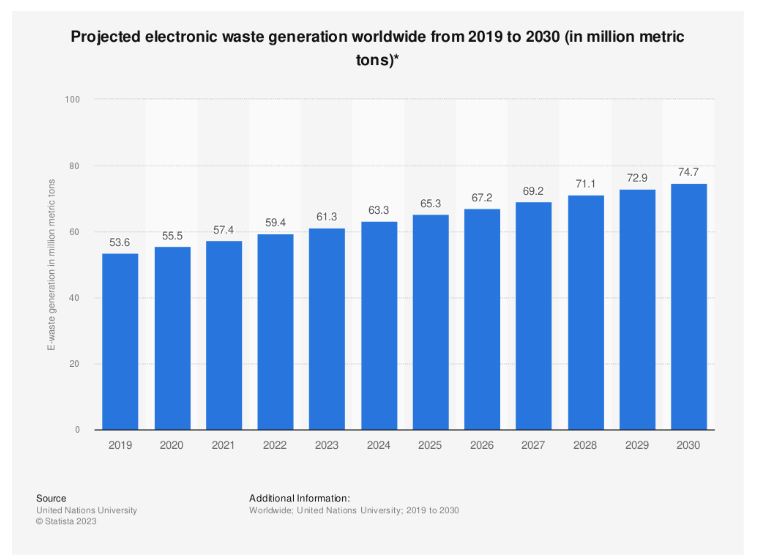
Types of e-waste include devices such as computers, laptops, mobile phones and lights, as well as large household appliances such as fridges, microwaves, and washing machines that make up the largest volume of collected e-waste in the UK.
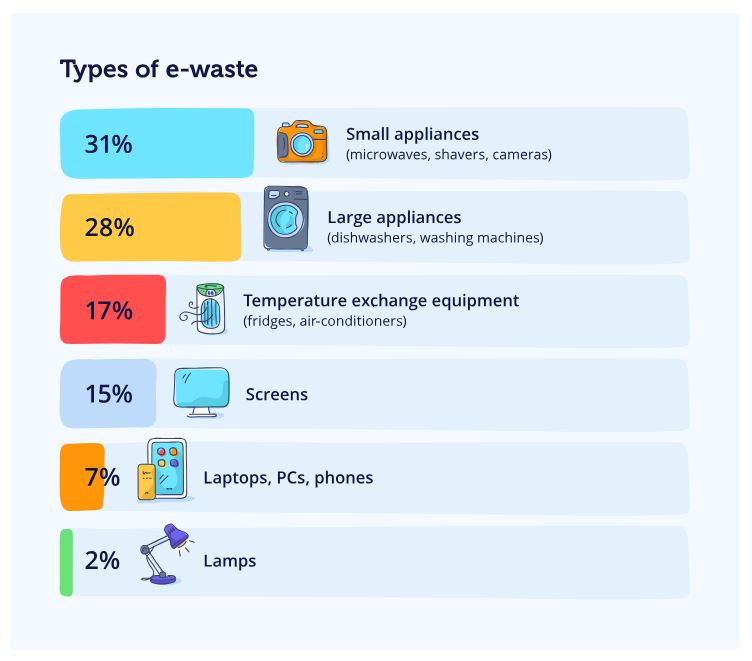
E-waste recycling
Globally, the average is 20% of e-waste is formally collected and recycled. The remaining 80% is either discarded in landfill, burned or illegally traded and treated in a sub-standard way every year. E-waste in landfills contaminates soil and groundwater, putting food supply systems and water sources at risk.
According to the World Health Organisation globally, more than 18M children are exposed to these sites.
There is also confusion in consumers’ minds about how they should dispose of e-waste because the system is often complex. In many cases, e-waste is treated as normal household waste, rather than separated. Find out more about where to recycle your electrical items.
Without a reliable waste management system, toxic substances contained in e-waste are more likely to be released into the environment and harm the people who live, work and play in e-waste scrapyards.
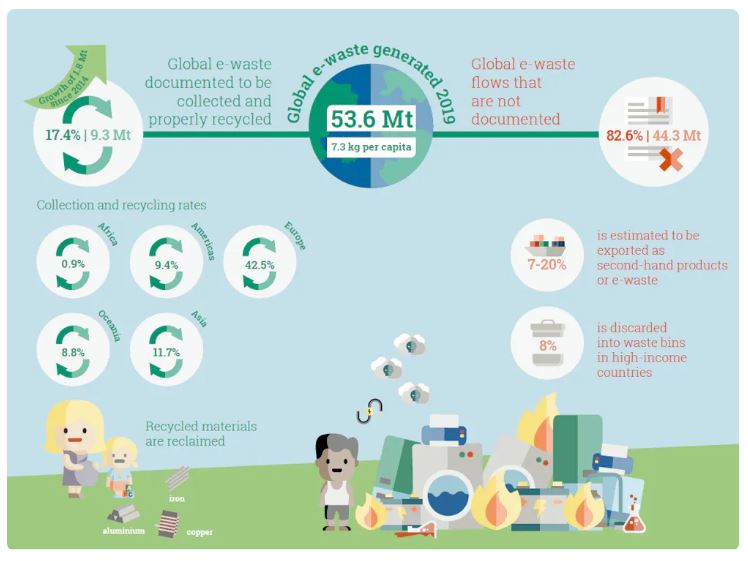
Not all bad news!
Thankfully, the world is slowly waking up to the scale of this problem. At the end of 2019, 78 countries were either covered by legislation, had a policy for managing e-waste or were putting regulation in place.
Circular Economy
“A circular economy is a system in which all materials and components are kept at their highest value at all times, and waste is designed out of the system. It can easily be thought of as the opposite of today’s linear economy. It can be achieved through different business models including product as a service, sharing of assets, life extension and finally recycling.”
World Economic Forum – A new circular vision for electronics
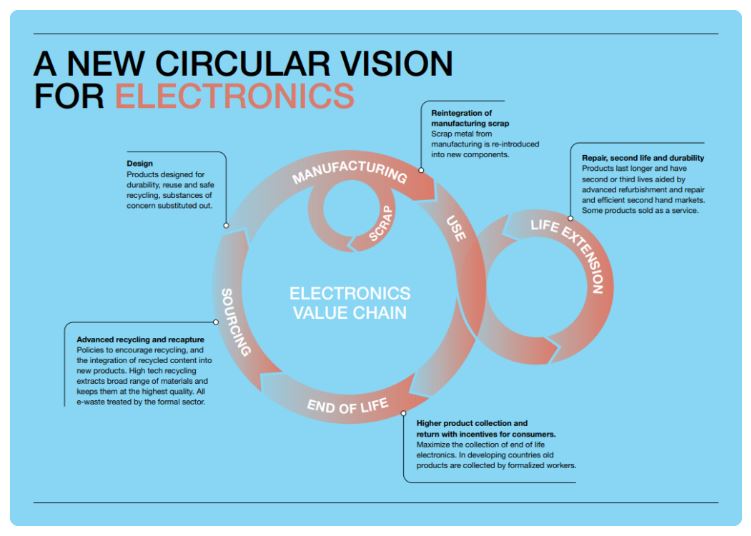
Extending the life of electronic products and re-using electrical components brings an even larger economic benefit, as working devices are worth more than the materials they contain. A circular electronics system – one in which resources are not extracted, used and wasted, but re-used in countless ways – creates responsible, sustainable jobs and retains more value in the industry.
Sustainable ICT and digital services strategy
Sustainability is central to the procurement, design and management of digital services and ICT to reduce costs and carbon emissions.
The UK government’s Sustainable ICT and Digital Services Strategy (2020-25) defines how, working together, we can provide responsible and resilient digital services and ICT to all our end users and customers across:
- Government departments, agencies and bodies
- Public sector
- Industry
- Professional and technical bodies
- Academia
- Charities
The strategy aims to minimise e-waste through responsible disposal and recycling practices, encouraging the implementation of circular economy principles.
Business rules
The stretch targets for 2025 have been developed to aide ambition. Progress towards these will be reported on an annual basis.
Rule 1: to meet net zero by 2050.
Rule 2: circular economy – resources and waste strategy.
Rule 3: to meet transparency and accountability commitments.
Delivery of the strategy is designed to generate the following outcomes:
- Reduced carbon emissions and costs
- Increased resilience
- Increased responsibility (doing the right thing)
- Increased transparency and collaboration
- Increased accountability
IT Asset Disposition
IT Asset Disposition (ITAD) is an industry practice built around reusing, recycling, repurposing, repairing or disposing of unwanted IT equipment in a safe and environmentally responsible way.
What does ITAD do?
IT asset disposition focuses on the following:
- Securing data. Old hardware may still contain data, so ITAD providers follow best practices for thorough data deletion. Storage devices are securely wiped.
- Recycling and reusing devices. ITAD providers dispose of numerous types of used hardware, including desktops, laptops, servers, phones and tablets. Items such as RAM sticks or video cards can be harvested and reused in other products or recycled.
- Repairing hardware. ITAD services may also offer repair options for hardware so organizations can repurpose their equipment.
Organisations doing something about it
Sun Screen IT
Sun Screen IT is the world’s first ethical IT Asset Disposal non-profit business and IT Education Charity group.
Founded after meeting teachers from West Africa in 2008, the group has grown to provide IT and asset disposal services in partnership with Centerprise International who are ADISA Standard 8.0 certified to DIAL 3 with distinction. ADISA Standard 8 is approved by the ICO and is part of the UK GDPR Certification Scheme. It donates 100% of its profits to its registered charity, which deploys sustainable IT access to young people in areas of economic need in the UK and abroad.
Its customers include office-based organisations, global retailers, major utilities, banks, and large public sector organisations. They receive data and e-waste certificates (in accordance with the highest level of GDPR & ISO accreditation) and personalised Environmental, Social and Governance (ESG) reports showing the carbon emissions (CO2e), water (H2O) and raw material mining savings achieved by using one of Sun Screen IT’s global ITAD partners.
Case study:
- Sun Screen IT projects: Impact Statement – Sierra Leone current project; PJ Cole – Queens Young Leader
IGEL
IGEL helps reduce an organisation’s carbon footprint by using aging hardware for longer, optimising resources across its IT infrastructure and reducing energy consumption, generating a positive effect on IT budget savings.
IGEL’s endpoint management solutions help to extend the life of devices by optimising performance, providing regular updates and security patches, supporting legacy hardware, leveraging thin clients and VDI solutions. By making the most of existing hardware and efficiently managing devices, organisations can reduce the need for frequent hardware replacements, resulting in cost savings and a more sustainable IT environment.
Case study:
- IGEL video library: City of Tigard turns to IGEL to ensure smooth running computing for city employees
Px3
Many organisations find the whole process of establishing the carbon footprint of their computing devices daunting and potentially costly – particularly when they need to measure IT energy use and manufacturing, transport and disposal. The Px3 tool is designed to simplify IT carbon footprint reporting from these diverse and widely distributed devices.
The tool estimates ‘scope 2’ (use) electricity consumption (kWh/y), ‘scope 3’ (supply chain) GHG emissions (kgCO2e) and carbon offset values for all computing device types commonly used in the workplace including notebooks, desktops, tablets and monitors.
The tool is free to use for organisations within the commercial, public and third sectors, with no subscription fees and a simple registration process.
Case study:
- Case Studies, References & Feature Articles: New Px3 research for Google on public sector IT published
Conclusion
In this technological and environmental era, the evolution towards green and sustainable IT emerges as a beacon of hope. As we have explored the scale of the problem, e-waste recycling path and some of the basics of a sustainable ICT and digital strategy, it becomes evident that the fusion of innovation and environmental responsibility is not only possible but imperative.
By aligning our digital strategies with sustainable principles, we not only alleviate the strain on our planet’s resources but also open avenues for improved efficiency, reduced costs, and enhanced resilience in the face of rapidly changing global challenges. Embracing energy-efficient hardware, optimising data centres, and prioritising circular economy models can all contribute to a future where technology harmonises with nature, rather than exploiting it.
Together, we can embrace a new narrative – one that redefines progress and empowers us to stride confidently towards a horizon where IT doesn’t just stand for Information Technology, but for Ingenious Transformation, where sustainability stands as the cornerstone of our digital legacy.
Useful links
- Greening Government: ICT and Digital Services Strategy 2020-2025 (GOV.UK)
- Electronic Waste and the Circular Economy (House of Commons)
- Power to Your Procurement (Crown Commercial Services))
- Paradise lost (IGEL)
- Regulations: Waste Electrical and Electronic Equipment (WEEE) (GOV.UK)
- Global E-waste Statistics Partnership (Global Waste)
- Recycling electrical items (Recycle Now)
- ITU e-waste videos (ITU)
For more information on sustainable IT and find out how CiRecycling can help you please contact us.

